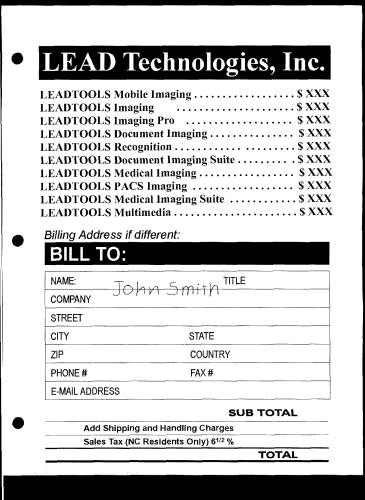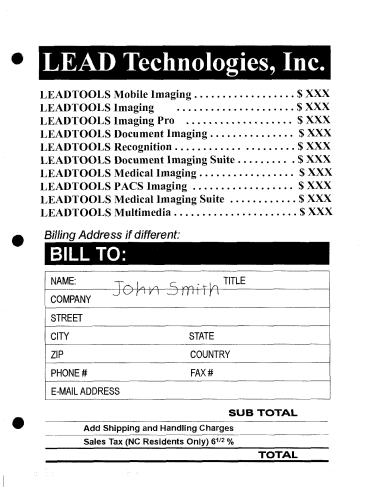L_BorderRemoveBitmap (original) (raw)
Summary
Removes the black borders in a 1-bit black and white image.
Syntax
#include "l_bitmap.h"
L_LTIMGCOR_API L_INT L_BorderRemoveBitmap(pBitmap, pBorderRemove, pfnCallback, pUserData, uFlags)
Parameters
pBITMAPHANDLE pBitmap
Pointer to the bitmap handle referencing the bitmap from which to remove borders.
pBORDERREMOVE pBorderRemove
Pointer to the BORDERREMOVE structure that LEADTOOLS uses to remove borders.
BORDERREMOVECALLBACK pfnCallback
Optional callback function for additional processing.
If you do not provide a callback function, use NULL as the value of this parameter. If you do provide a callback function, use the function pointer as the value of this parameter.
The callback function must adhere to the function prototype described in BORDERREMOVECALLBACK Function.
L_VOID *pUserData
Void pointer that you can use to pass one or more additional parameters that the callback function needs.
To use this feature, assign a value to a variable or create a structure that contains as many fields as you need. Then, in this parameter, pass the address of the variable or structure, casting it to L_VOID *. The callback function, which receives the address in its own pUserData parameter, can cast it to a pointer of the appropriate data type to access your variable or structure. If the additional parameters are not needed, you can pass NULL in this parameter.
L_UINT32 uFlags
Reserved for future use. Must be 0.
Returns
| Value | Meaning |
|---|---|
| SUCCESS | The function was successful. |
| < 1 | An error occurred. Refer to Return Codes. |
Comments
This function does not support signed data images. It returns the error code ERROR_SIGNED_DATA_NOT_SUPPORTED if a signed data image is passed to this function.
(Document) This function removes borders that commonly appear in scanned text documents. Any or all of the four borders can be detected and removed. The behavior of this function can be modified by using its callback.
This function works only on 1-bit black and white images.
If a region is selected, only the selected region will be changed by this function. If no region is selected, the whole image will be processed.
This function does not support 32-bit grayscale images. It returns the error code ERROR_GRAY32_UNSUPPORTED if a 32-bit grayscale image is passed to this function.
Border Remove Function - Before

Border Remove Function - After

View additional platform support for this Border Remove function.
Required DLLs and Libraries
- LTIMGCOR
- For a listing of the exact DLLs and Libraries needed, based on the toolkit version, refer to Files To Be Included With Your Application.
Platforms
Win32, x64, Linux.
See Also
Functions
- BORDERREMOVECALLBACK
- L_SmoothBitmap
- L_LineRemoveBitmap
- L_AutoLineRemove
- L_InvertedTextBitmap
- L_DotRemoveBitmap
- L_HolePunchRemoveBitmap
- L_HolesRemovalBitmapRgn
- L_AutoBinarizeBitmap
- L_DynamicBinaryBitmap
- L_AutoBinaryBitmap
- L_InvertedPageBitmap
Topics
Example
This example returns a region corresponding to the borders of a bitmap
For the example, windows regions are returned in the callback and combined.
Inn practice it would easier and faster to just return a LEAD region representing the changes
The border is removed from the image
L_INT EXT_CALLBACK ExampleBorderRemoveCB(HRGN hRgn, L_UINT32 uBorderToRemove, LPRECT pBoundingRect, L_VOID* pUserData)
{
L_TCHAR szMsg[200];
L_TCHAR* pszBorder = NULL;
HRGN hRgnAll;
hRgnAll = (HRGN)(pUserData);
CombineRgn(hRgnAll, hRgnAll, hRgn, RGN_OR);
DeleteObject(hRgn);
switch (uBorderToRemove)
{
case BORDER_TOP:
pszBorder = TEXT("Top");
break;
case BORDER_LEFT:
pszBorder = TEXT("Left");
break;
case BORDER_RIGHT:
pszBorder = TEXT("Right");
break;
case BORDER_BOTTOM:
pszBorder = TEXT("Bottom");
break;
}
wsprintf(szMsg,
TEXT("Border[%s]\tBounds[%d,%d][%d,%d]\n"),
pszBorder,
pBoundingRect->left,
pBoundingRect->top,
pBoundingRect->right,
pBoundingRect->bottom);
OutputDebugString(szMsg);
return SUCCESS_REMOVE;
}
extern "C" L_INT BorderRemoveBitmapExample()
{
L_INT32 nRet;
BORDERREMOVE br;
HRGN hRgnAll;
BITMAPHANDLE LeadBitmap; /* Bitmap handle to hold the loaded image. */
BITMAPHANDLE RegionBitmap;
/* Load the bitmap, keeping the bits per pixel of the file */
nRet = L_LoadBitmap(MAKE_IMAGE_PATH(TEXT("Clean.tif")), &LeadBitmap, sizeof(BITMAPHANDLE), 0, ORDER_BGR, NULL, NULL);
if (nRet != SUCCESS)
return nRet;
memset(&RegionBitmap, 0, sizeof(BITMAPHANDLE));
//Create a NULL region
hRgnAll = CreateRectRgn(0, 0, 0, 0);
br.uStructSize = sizeof(BORDERREMOVE);
br.iBorderPercent = 20;
br.iVariance = 2;
br.iWhiteNoiseLength = 5;
br.uBorderToRemove = BORDER_TOP | BORDER_BOTTOM | BORDER_LEFT | BORDER_RIGHT;
br.uFlags = BORDER_CALLBACK_REGION | BORDER_USE_VARIANCE;
br.pBitmapRegion = &RegionBitmap;
br.uBitmapStructSize = sizeof(BITMAPHANDLE);
nRet = L_BorderRemoveBitmap(&LeadBitmap, &br, ExampleBorderRemoveCB, (L_VOID*)hRgnAll, 0);
if (nRet != SUCCESS)
return nRet;
RECT rectRgn;
GetRgnBox(hRgnAll, &rectRgn);
if (!IsRectEmpty(&rectRgn))
{
nRet = L_SetBitmapRgnHandle(&LeadBitmap, NULL, hRgnAll, L_RGN_SET);
if (nRet != SUCCESS)
return nRet;
DeleteObject(hRgnAll);
}
return SUCCESS;
}